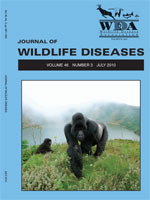Increasing urbanization has important consequences for wildlife, including the potential for higher prevalence of diseases within “urban adapter” species exposed to spillover from domestic animals. We investigated whether prevalence of antibodies to Toxoplasma gondii in woodchucks (Marmota monax) was related to urbanization in a Midwestern landscape. We collected serum samples from adult woodchucks captured across an urban–rural gradient in Illinois, USA in May–November 2007. We used an indirect fluorescent antibody test (IFAT) on the serum samples to detect T. gondii antibodies. Five of 35 (14.3%) sera from woodchucks had detectable T. gondii antibodies. Prevalence was related positively to urbanization. All positive samples were from individuals inhabiting areas in which urban land cover exceeded 70%. Urban woodchucks are likely exposed to high levels of T. gondii oocysts in the environment due to habitat overlap with the definitive hosts for the parasite, domestic and feral cats, which reach high densities in urban areas.
How to translate text using browser tools
1 July 2010
Prevalence of Antibodies to Toxoplasma gondii in Woodchucks across an Urban–rural Gradient
Elizabeth W. Lehrer,
Shannon L. Fredebaugh,
Robert L. Schooley,
Nohra E. Mateus-Pinilla
ACCESS THE FULL ARTICLE

Journal of Wildlife Diseases
Vol. 46 • No. 3
July 2010
Vol. 46 • No. 3
July 2010
Marmota monax
Toxoplasma gondii
urbanization
Woodchuck




